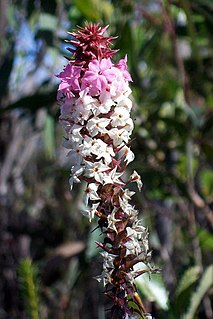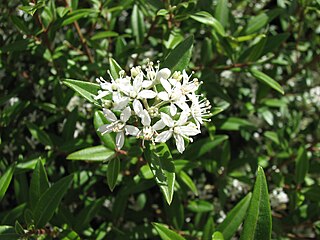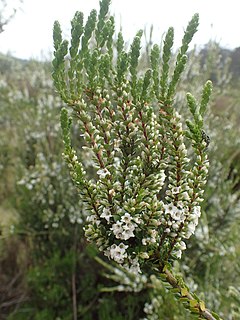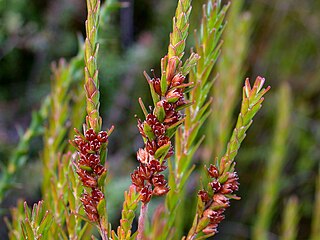
Epacris impressa, also known as common heath, is a plant of the heath family, Ericaceae, that is native to southeast Australia. French botanist Jacques Labillardière collected the species in 1793 and described it in 1805. Four forms have been identified, but no subspecies are recognised. Growing in heathland, shrubland or open forest, it is generally a small shrub around 0.5 to 1 m tall, with small stiff leaves. The red, pink or white tube-like flowers appear from late autumn to early spring. Honeyeater birds, particularly the eastern spinebill, feed upon the nectar of the flowers. It regenerates after bushfire by seed or by resprouting.

Epacris is a genus of about forty species of flowering plants in the family Ericaceae. It was formerly treated in a closely related but separate family Epacridaceae, but the various genera within Epacridaceae including Epacris have been revised in their relationships to each other and brought under the common umbrella of the Ericaceae. The genus Epacris is native to eastern and southeastern Australia, New Caledonia and New Zealand. The species are known as heaths or Australian heaths.

Woollsia is a monotypic genus in the family Ericaceae. The sole species, Woollsia pungens, known as snow heath, is a small shrub found in eastern Australia, from Pigeon House Mountain in southern New South Wales north into Queensland.

Billardiera longiflora, the purple apple-berry, is a small Australian vine found in cool, moist forests from southern New South Wales to Tasmania, where it is native. It was described by French botanist Jacques Labillardière in 1805. The slender leafed vine has greenish-yellow flowers and shiny purple fruit. The fruit is edible.

Archeria is a small genus of shrubs in the family Ericaceae. As currently circumscribed the group includes six species, all native to southern Australasia. Four of these are endemic to Tasmania, and the other two endemic to New Zealand.

Dodonaea triquetra, known as common hop bush or large leaf hop bush, is a species of shrub occurring in eastern Australia.

Pittosporum bicolor, commonly known as cheesewood or banyalla, is a flowering shrub or small tree of the Pittosporaceae family, and is native to south eastern Australia.

Nematolepis squamea , commonly known as Satinwood, is an upright shrub or small tree species which is endemic to Australia. The species was first formally described in 1805 and named Eriostemon squamea. It was transferred to the genus Phebalium in 1896 and subsequently to Nematolepis by Paul G. Wilson in 1998. The name is derived from the Greek words nematos 'thread', lepsis 'scale' and the Latin word squameus 'scaly' referring to the scales on the leaves, stems and stamens.

Epacris obtusifolia is common plant from the heath family. The blunt-leaf heath grows in swampy areas and heathland in eastern Australia. It is usually seen growing less than a metre tall. Flowers form in any time of the year, but are mostly seen between July and January.
Archeria comberi, also known as the pink mountain heath or comb heath, is a small, rare shrub endemic to Tasmania, Australia. As a member of the heath family, Ericaceae, this species is generally classified as a subalpine/ alpine species and shares many characteristics with other members of the family. It is an evergreen shrub 0.15m-1m in height, with pink flowers during the summer months, hence its common name pink mountain heath. Archeria comberi is often found growing among other species such as Nothofagus gunnii and Persoonia gunnii.

Orites revolutus , also known as narrow-leaf orites, is a Tasmanian endemic plant species in the family Proteaceae. Scottish botanist Robert Brown formally described the species in Transactions of the Linnean Society of London in 1810 from a specimen collected at Lake St Clair. Abundant in alpine and subalpine heath, it is a small to medium shrub 0.5 to 1.5 m tall, with relatively small, blunt leaves with strongly revolute margins. The white flowers grow on terminal spikes during summer. Being proteaceaous, O. revolutus is likely to provide a substantial food source for nectivorous animal species within its range.

Monotoca scoparia, commonly known as prickly broom heath, is a widespread native species across south-eastern Australia. Monotoca scoparia was formerly in the family Epacridaceae but now belongs to the family Ericaceae. Monotoca is an endemic Australian genus with 17 described species occurring in all states.

Epacris rhombifolia commonly known as mountain coral heath, is a plant in the heath family Ericaceae and is endemic to eastern Australia. It is an erect, multi-stemmed shrub with broad, rhombic leaves and white flowers with four petals, the flowers spreading down the branches. It only grows in wet, subalpine heath and is sometimes regarded as a variety of Epacris microphylla.

Prionotes is a genus of flowering plants endemic to Tasmania, with a single species, Prionotes cerinthoides. Commonly known as climbing heath, it is a temperate rainforest climber or a small scrambling shrub in the mountains. It usually lives in very wet, undisturbed places.

Hakea lissosperma, commonly known as needle bush and mountain needlewood, is a species of Hakea native to parts of south eastern Australia.

Epacris lanuginosa, commonly known as woolly-style heath or swamp heath, is a riparian angiosperm. Its conservation status is listed as 'Not threatened'.

Baeckea gunniana, commonly known as alpine baeckea, is a species of a compact, densely branched evergreen shrub, growing in alpine and sub-alpine Australia. Baeckea is a genus of flowering plants in the myrtle family, Myrtaceae, comprising 14 species occurring in eastern Australia and Asia.

Epacris corymbiflora, commonly known as straggling heath, is a plant of the heath family, Ericaceae and subfamily, Epacridoideae. It is a small, erect shrub, with softly pointed, green diamond shaped leaves, and white tubular flowers that form a dense spherical group. Epacris corymbiflora is endemic to Australia’s island state of Tasmania and found in heath and coastal vegetation communities.

Trochocarpa cunninghamii is a flowering plant species of the family Ericaceae. It is commonly referred to as straggling purpleberry due to its round flattened mauve drupe fruits. This woody shrub is usually found in the understorey of rainforests and subalpine forests in the Central Plateau and western Tasmania, and is endemic to Tasmania.

Coprosma moorei, commonly known as blue matcurrant or turquoise coprosma, is a small, mat forming, prostrate shrub in the Rubiaceae family. It is native to highland areas of Tasmania and Eastern Victoria.




















